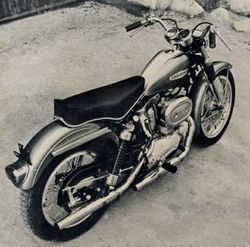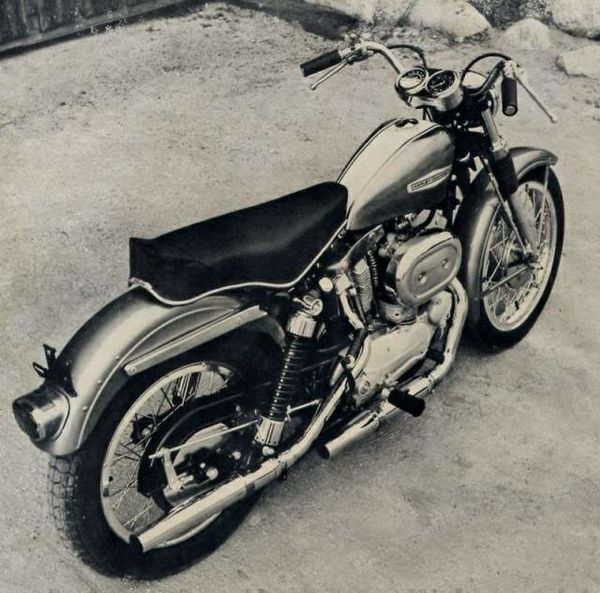Harley-Davidson XLCH 900 Sportster
 |
|
| Harley-Davidson Sportster 883 | |
| Manufacturer | |
|---|---|
| Also called | Sportster XL Ironhead, Sportster XLCH Ironhead, Sportster XLCH, XLCH 900 Sportster, 883 Sportster Standard, 883 Sportster Hugger, XL53C Sportster Custom, XL 53 C Sportster Custom, Sportster Custom 883, Sportster 883 Hugger, XL53C Sportster Custom 53, XL 53C Sportster Custom 53, 883 Roadster, Sportster SuperLow, Sportster Iron 833, Sportster 883 Roadster, Sportster Iron 883 Dark Custom, Sportster Superlow, XLH900 Sportster, XLH Sportster, XLH 900 Sportster, XLCH Sportster, XL Sportster, Sportster Iron 883 |
| Production | 1965 - 68 |
| Engine | Four stroke, 45° V-Twin, OHV, 2 valves per cylinder. |
| Compression ratio | 9.0:1 |
| Top Speed | 116 mph |
| Ignition | Magnetic |
| Transmission | 4 Speed |
| Suspension | Front: Cartridge Rear: Dual shocks swinging arm fork |
| Brakes | Front: 200mm drum Rear: 200mm drum |
| Front Tire | 3.75-19 |
| Rear Tire | 4.25-18 |
| Weight | |
| Fuel Capacity | 8.5 Liters / 2.2 US gal |
| Manuals | Service Manual |
It could reach a top speed of 116 mph.
Engine[edit | edit source]
The engine was a Air cooled cooled Four stroke, 45° V-Twin, OHV, 2 valves per cylinder.. The engine featured a 9.0:1 compression ratio.
Chassis[edit | edit source]
It came with a 3.75-19 front tire and a 4.25-18 rear tire. Stopping was achieved via 200mm drum in the front and a 200mm drum in the rear. The front suspension was a Cartridge while the rear was equipped with a Dual shocks swinging arm fork. The XLCH 900 Sportster was fitted with a 8.5 Liters / 2.2 US gal fuel tank.
Photos[edit | edit source]
Overview[edit | edit source]
Harley Davidson XLCH 900 Sportster
Cycle Magazine of 1965
From the attitude we find among some riders we meet, one would think the Harley-Davidson Motor Co. had lost all interest in making motorcycles for the general public. This attitude, which we think is peculiar to Southern California, has it that Harleys are good for policemen and a few old men who never quite got over the fact that Indian went out of business. Actually, quite the reverse is true. Harley-Davidson survived while the other old line American companies went under precisely because they competed actively with European cycle makers and either matched them or beat them at their own game. Harleys are selling better than ever today because there are (as there always have been) a certain number of buyers in the market who want a combination of tremendous power and great dependability, and there are few European makers who offer both in a single package. The Sportster, both in the XLH and XLCH models, is a perfect example of such a package, and it is Harley's big gun against such imports as Triumph, BSA, BMW and other large machines. If you have never ridden the 55, the first ride will be remembered for a long, long time. The first impression is one of tremendous weight (which there is) , but then it lightens up once you get going. After awhile you let yourself loosen up and ride it like any other motorcycle; then you realize that little old you can actually be the master of that big machine. Our test staff that day consisted of four riders ranging in weight from 120 to 180 pounds, and not one of us felt cowed by either of the two bikes. We took two to see if we could find a clearcut difference between the XLH and XLCH. We found them very much alike. The H had a 3.7 gal. tank, separate pipes, full-dress headlight assembly, wide, horizontal handlebars. The CH had a 2.3 gal. tank, single exhaust pipe, semi-dress headlight assembly and narrow, semi-vertical handlebars. Actually, either model can be ordered with either tank, either pipe setup, either headlight and either handlebars. The real difference is in the gearing (10.63 top for the H, 11.16 for the CH) and ignition (coil for the H, magneto for the CH) . The result is that the CH is just a wee bit hotter. We were able to turn 94 in the standing quarter with the CH and only 90 with the H, despite the fact that the CH was saddled with a single pipe, creating greater back pressure. So, unless you plan to use the bike for competition, in which a slight performance edge can make a big difference, your choice between the two models is purely a matter of personal preference. Naturally, the Sportster does best on the open road, and this is where we derived the greatest enjoyment from it. If you're the kind of rider who sticks close to home, you don't need one. Its capacity for long, hard running is unmatched by any other motorcycle, and its torque range is phenomenal. Though it is possible to gain advantage by shifting down, in most highway situations you simply forget there is any other gear but top. .At 35 mph, for instance, a sudden turn of the throttle to full on makes the machine jump like a frightened gazelle. The controls, we found, were perfectly placed, despite a considerable variance in rider size. The gear shift was a bit on the spongy side, but that is a matter of preference, as there is a tighter control spring available to alter this. Likewise, all of us preferred the wide, horizontal handlebars, as we felt they gave us better control. But again, there are two available.. The throttle has no return spring, and we did not like that. But our local dealer assured us that Harley riders prefer it that way, and that he has few calls for conversions. Worse than that, however, was the play in the throttle, which made control somewhat difficult until we got used to it. Since both machines had it in equal amount, we concluded it was not just a maladjustment, and we would change it if we owned one. Like the big 1200, the Sportster retains a hand spark control in combination with an automatic advance. This may sound like old hat, but it's a darned good thing to have when starting up. An engine of that size has a tremendous kick to it, and a backfire just as you are midway in the kick could break your leg. By turning the spark control to full retard it is almost impossible to be kicked by this machine. Once you have it running you turn the control to full advance and the automatic takes care of the rest. To sum it up, we have to admit that the Sportster is not designed for just anybody, least of all the young fellow just graduating from a Honda 50. But for a man with two or three years of riding experience under his belt, who wants a powerful machine that is still sporty, we can think of nothing else that will quite fill the bill. Its torque and speed in highway situations are positively exhilarating. Unless you aim to set a new land speed record, it is the fastest thing you could possibly want Source Cycle Magazine of 1965
| Make Model | Harley Davidson XLCH 900 Sportster |
|---|---|
| Year | 1965 - 68 |
| Engine Type | Four stroke, 45° V-Twin, OHV, 2 valves per cylinder. |
| Displacement | 882 cc / 53.8 cu-in |
| Bore X Stroke | 76.2 x 96.8 mm |
| Cooling System | Air cooled |
| Compression | 9.0:1 |
| Lubrication | Dry sump |
| Induction | Single 1.625 in., Williston |
| Ignition | Magnetic |
| Starting | Kick |
| Max Power | 60 hp / 44.7 Kw @ 6800 rpm |
| Max Torque | NA |
| Transmission | 4 Speed |
| Final Drive | Chain |
| Front Suspension | Cartridge |
| Rear Suspension | Dual shocks swinging arm fork |
| Front Brakes | 200mm drum |
| Rear Brakes | 200mm drum |
| Front Tire | 3.75-19 |
| Rear Tire | 4.25-18 |
| Weight | 214 kg / 471.7 lbs |
| Fuel Capacity | 8.5 Liters / 2.2 US gal |
| Standing ¼ Mile | 14.1 sec / 92 mph |
| Top Speed | 116 mph |
